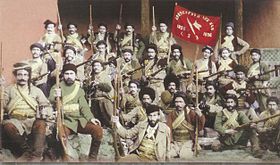
Back فدائيون أرمينيون Arabic فدائيو ارمن ARZ Erməni quldur dəstələri Azerbaijani Армянскія фідаі Byelorussian Fedayi (Armenier) German Αρμένιοι φενταΐ Greek Armena milico Esperanto Unidades irregulares armenias Spanish فدایی ارمنی Persian Fédaïs arméniens French
This article needs additional citations for verification. (April 2023) |
This article possibly contains original research. (April 2023) |
| Armenian fedayi | |
|---|---|
 A fedayi group fighting under the ARF banner. The banner reads Liberty or Death. | |
| Active | 1880s–1920s |
| Country | Ottoman Empire Russian Empire Qajar Iran |
| Allegiance | Armenians |
| Type | Militia |
| Size | 40,000 during the Armenian genocide |
| Engagements | Armenian national movement Persian Constitutional Revolution Resistance during the Armenian genocide |
| Commanders | |
| Before 1893 | Arabo |
| 1893–1899 | Aghbiur Serob |
| 1899–1904 | Andranik |
| 1904–1907 | Kevork Chavush |
Fedayi (Eastern Armenian: Ֆիդայի, romanized: Fidayi; Western Armenian: Ֆէտայի, Fedayi, Turkish: Ermeni milisleri, çeteleri, fedaileri, French: Fédaïs arméniens), also known as the Armenian irregular units, Armenian militia, or Armenian Hayduks were Armenian civilians who voluntarily left their families to form self-defense units and irregular armed-bands in reaction to the mass murder of Armenians and the pillage of Armenian villages by criminals, Turkish and Kurdish gangs, Ottoman forces, and Hamidian guards during the reign of Ottoman Sultan Abdul Hamid II in late-19th and early-20th centuries, known as the Hamidian massacres. Their ultimate goal was always to gain Armenian autonomy (for Armenakans) or independence (for Dashnaks and for Hunchaks) - depending on their ideology and the degree of oppression visited on Armenians.
Some of the key fedayi figures also participated in the Iranian Constitutional Revolution that commenced during the same period, upon agreement of the ARF leaders.
The Armenian term fedayi ultimately derives from the Arabic word fedayeen: فدائيون fidā'īyūn, literally meaning "those who sacrifice".[1][2] The term hayduk was also used interchangeably as well and derived from the Hungarian word hajduk, meaning "foot soldier".
- ^ Middle East Glossary - The Israel Project: FEDAYEE Archived 2012-04-27 at the Wayback Machine
- ^ Tony Rea and John Wright (1993). The Arab-Israeli Conflict. Oxford University Press. p. 43. ISBN 019917170X.